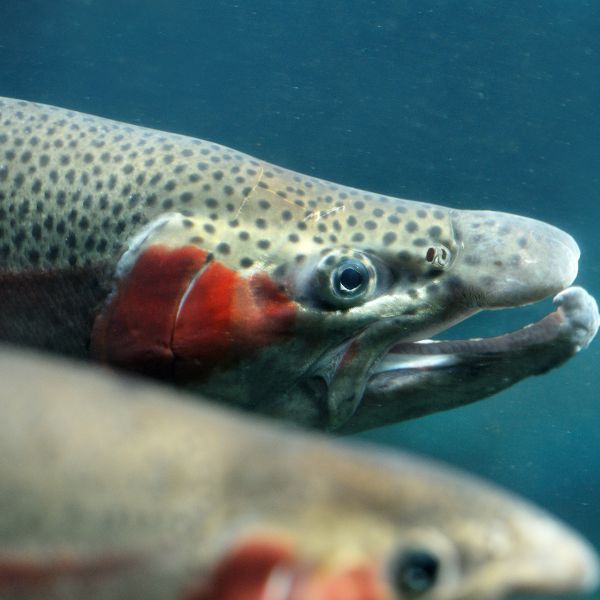There is something special about landing a big trout. The dream and motivation for many trout fishermen is to land that trout of a lifetime. The one worthy of mounting on the wall above the fireplace, and bragging about at the pub after a few beers.
In this guide, I will share many hints, tips, and secrets to increase the chance of catching that trout of a lifetime. Hopefully allowing your dream to come true. Each section will focus on one specific aspect which will help increase your chance of not only finding, maybe even landing that trophy trout.
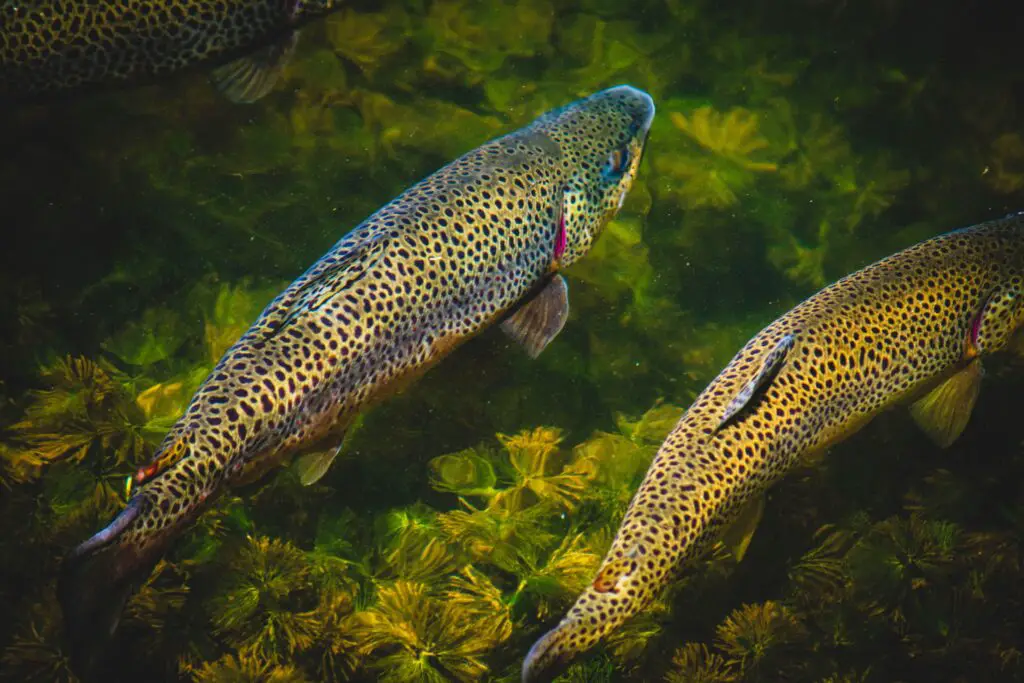
How to define a Trophy Trout?
Something everyone agrees upon is that a trophy trout is a large fish. Some might even be tempted to mount them on the wall. Putting a hard figure on just how big a trout has to be is a matter of opinion and it varies greatly based on location and target species.
Many trout anglers consider a brown or rainbow trout weighing over 10lb or exceeding 30 inches in length to be worthy of the trophy title. Although that is an oversimplification because a trophy size trout is a matter of opinion.
Some hatchery programs stock trophy size trout, but these are usually smaller size fish. For example, the Oregon Department of Fish and Wildlife for their stocking program considers a trout greater than 15″ to be a trophy.
So there is certainly a lot of nuance to the exact size of a trophy trout. I personally like the 10lb figure, it is a nice prominent number. In most streams, rivers, and lakes a 10lb brown or rainbow is a big trout and many anglers will consider it a fish of a lifetime. Many anglers fish their whole life without catching a 10lb trout.
In some hydro canals, tailwater, and coastal fisheries trout up to and exceeding 20lb are not unheard of, and world record trout, both Brown and rainbow now exceed 40lb. Given the right environment, trout can grow to monstrous sizes.
Some of the biggest trout are found living beneath fish farms where they gorge themselves on the nearly endless supply of energy rich fish pellets. Such obese trout can be found in the likes of the Tekapo Canals in New Zealand, Lake Diefenbaker in Canada. In such environments, a 10lb trout can be towards the small end.
It is also very species dependent. Not all trout grow so large. Smaller species of trout such as Brook’s rarely reach 10lbs, so for most brook fisheries, a 6 or 7lb trout is a remarkable fish.
So a trophy trout might be best defined as a trout that is large in its current habitat.
8 Hints to Catch a Trophy Trout
1# Large Trout Live Where People Rarely Fish
Trout are known to be shy and cunning fish. Large trout are often the most cunning of the lot. A trout does not become the biggest in its stream by getting caught or hiding all day.
So the biggest trout, usually live in areas that are difficult to access. There they can feed undisturbed, and not waste precious feeding time hiding beneath a logjam because a constant stream of anglers constantly disturbs them.
To find such locations, you do not need to travel to the middle of nowhere. In some of the most famous trout waters have stretches that are rarely fished. It might be challenging, adventurous, and sometimes even a little dangerous to reach them. But if you are paired and skilled enough it can certainly be worth the effort.
These waters are often in inaccessible gorges, surrounded by thick scrub or swampy reed-infested shorelines. The keen and most determined trout fishermen still find a way. Some abseil down with climbing gear, others ride down in rafts. Tubes, packrafts, and fishing kayaks are great options for reaching less accessible locations.
I have even swam in freezing mountain streams, clumber up small waterfalls, and boisterous rapids in a thick wetsuit to get my chance to fish inaccessible pools. Sometimes I got cold for no reason, but often enough I strike gold.
Not all spots have to be that challenging or inaccessible. In general the further from the parking lot you walk, the less likely you have to contend with other anglers. The less angling pressure a pool or ripple has the greater the odds you will encounter that resident lurker.
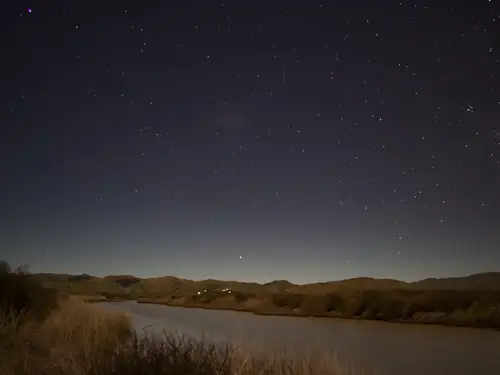
2# Large Trout Feed While we Sleep
Most people fish during the day, a few keen anglers might fish in the morning and dusk raises. The keenest are on the river in the middle of the night, even into the early hours of the morning.
This applies more to brown trout than rainbows, but many of the largest dominant trout live a nocturnal lifecycle. So while a pool might seem empty during the day, at 1am it could be an entirely different story. It is well known, that large brown trout, in particular, are very nocturnal in their feeding habits.
I remember reading one research paper, where they tracked the movement of some fairly large brown trout for an entire year. The researchers found they did the majority of their feeding between midnight and 1am, and then again between 4am and dawn.
At night, It can be worth just setting quietly and listening beside deep pools. Sometimes you can hear the tell-tale splashes of a trout chasing baitfish. In such situations, I like to fish a ‘minnow imitation. Fly anglers might cast a large wooly bugger. While spinners should reach for a jerkbait. If bait fishing is allowed, a live minnow is by far the most effective option.
In my local trout fishing club. There were a couple of elderly trout fishermen. One who was well into his 90s was a great advocate of night fishing. He and his wife on a calm night will drive down to the lower reaches of the river in the early hours of the morning. There they just sit in the car and listen. When a fish is heard feeding. He makes his way down to the river edge and cast out a grey ghost, woolly bugger or rabbit strip streamer and the fight is on. His results spoke for themselves. Spin fishing with a dark Jerkbait can have equally rewarding success. Fishing the same parts of the river during the day is often an exercise of futility because the large trout are held up beneath overhangs and other impenetrable vegetation.
The other gentleman uses live bait. He makes his way to the river often in the early hours of the morning. There he sets about catching live minnows, he does so in two ways. Sometimes by using the tiniest of hooks, other times he spotlights and scoops them up in a butterfly net. With the bait secure he live rigs the minnows under the smallest of floats (prevents them from hiding between the rocks) and set in wait. It normally does not take long before a hungry trout smashes into it. It is important not to set the hook too fast. Trout often stun their prey first before swooping back in to consume it. Much to the annoyance of the dedicated fly and spin fishermen he has caught some magnificent trout over the years and has a photo album second to none in the club.
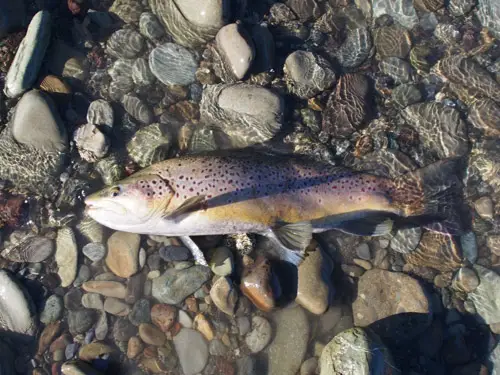
Additional technique-specific guides
- To learn the secrets of live baiting minnows for trout check here.
- For advice on fishing jerkbaits, check here.
- For advice fishing mouse flies check here.
#3 Follow the food | Find the big trout
The largest fish are usually where the best food is.
Like all trout, they like to lay where they use the less energy possible while maximizing their food intake. Finding an area rich in food is likely where you will also find trophy brown or rainbow trout.
The two main areas large trout are usually found are beneath fish farms. There they can steal a constant supply of energy rich pellets. These trout often grow large and obese. The structure of the fish farm overhead makes them difficult to cast at, and quite a few lures are lost to snags.
The next best location to find truly large trout is in the tailwaters downstream of hydro dams. Such tailwaters are often ideal trout habitats. The flow of water is consistent, and even in winter it rarely freezes over. Best of all, the turbines cut up a constant supply of ‘free food’ from the lake above.
There are some more natural sources of food. Some rivers get a yearly run of small baitfish, or migration of crabs then the trout will know about it. I often find the estuaries or larger lower reaches have larger numbers of baitfish.
Likewise, if there is a large hatch of insects or a plague of mice then the trout would likely be feeding on them. Mice hunting trout can grow to impressive sizes in only a few months.
In a similar vein, many large trout live downstream from power turbines. The trout lazily feed upon any fish or insects which were unlucky enough to get sucked through the turbine.
#4 Big trout need big water
Small streams and lakes might be picturesque but they normally do not have enough suitable habitats for large trout to live. Big trout like big water. There is a reason why the US record Brown Trout was caught at Lake Michigan. While the world record Rainbow trout were taken from lake Diefenbaker in Saskatchewan which is the junction of two major rivers.
Large trout might enter smaller side streams to spawn. They nearly always retreat back downstream in search of food but a few stick around. If you want to maximize the success of catching large trout in small streams, then fishing them early in the season is often the most rewarding. At the end of winter, the streams are normally still following strong and some big trout are a bit slow migrating back downstream after spawning.
It can also be rewarding looking for the biggest pool in a small stream. I keep remembering a story from a couple of hunters who were heading up a tiny mountain stream to their hunting ground. That stream is normally wide enough to step across without getting a wet boot. The stream is the last place any trout fishermen would venture. The whole catchment is poorly regarded as a trout fishery. Several hours from the road end, there is several giant boulders that form a natural wall over which a small waterfall had created a wide and deep plunge pool. From that pool, they pulled a trout weighing a respectable 7lb.
#5 Practice makes perfect
Sometimes the biggest trout live right under our nose, and if a trout is feeding it can be caught. Those big trout are cunning and it is tempting to think they have seen every trick in the book. That is simply not true.
You just need to outsmart them. Try to place your fly or lure in such a way that the trout does not even know you are there. You need to be pinpoint accurate with your casts. While positioning yourself in such a way to be invisible to the fish. If fly-fishing with a nymph a drag free presentation is essential.
While it might be tempting to think that a big trout need big bait. This is simply not always true, sometimes going super small is the secret. That means using a size 20 fly (maybe even smaller) if that is what the trout is feeding on. For spin anglers consider using a size 3 Rapala or other tiny jerkbait.
The time tested hybird approach of a fly beneath a float can also work wonders.
#6 Don’t follow the angler’s highway
If you want to catch a big trout on a popular river, you have to approach things differently. Some popular rivers have an easy side and a hard size to fish. 99% of trout fishermen choose to cast and walk along the easy side. No one wants to bash through thick scrub or scramble along a steep cliff. The trout in such rivers have learned that the easy side means danger, and that is where they are most observant.
If you put the effort in, and fish from the difficult side of the river you catch the trout off guard making it much easier to hook. But remember, hooking the trout is only half the challenge; You still need to fight and land it. Easier said than done when clinging onto a mossy cliff. In such cases, if safe I often jump into the river and swim to the other side to finish the fight.
7# Big Trout Need Stable conditions and clean cold water
Often the fisheries that produce the biggest trout are the most stable inflow. They are usually surrounded by nature or low-intensity farmland. The water is cold and clean, free of pollution and other containments.
Near where I grew up there is a main large trout river, into which flows seven significant tributaries. While they all contain trout, only one is famous for trophy fish. That river has a natural dam across its headwaters. Resulting in greatly reduced fluctuations of flow and severity of floods.
The presence of a lake, either natural or man made helps regulate a rivers flows during periods of drought, but also during heavy rainfall events. This is another reason why tailwaters are such productive fisheries. The dam regulates the flow.
Powerful floods are extremely damaging, not only killing trout but also disrupting the food supply. Rivers that see frequent, and large floods are unlikely to contain healthy trout fisheries.
Even more damaging than too much rain, is not enough. Low flows, even if the river does not completely run dry low flows are still extremely disruptive to a trout’s lifecycle. If the water gets too warm a trout stops feeding, if it gets even hotter they die.
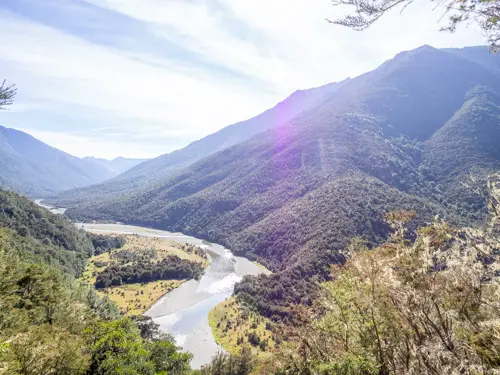
8# Persistence is key to catching your trophy trout
The more you fish, the more time you spend on the river, the more likely you are to catch a trophy trout. In many ways, fishing is a numbers game. With more time spent fishing the more honed your skills become, and the more experience you become.
You will learn where the fish like to feed, and where they lay, and you would even learn what flies or lures works best. Time spent fishing not only gives you more chances to catch a trophy trout, but it also gives you the skills to increase the odds that you actually catch that trout when you spot it.
9# All techniques catch trophy trout, do not limit yourself to one style
It does not matter if you are a fly, spin, or even bait angler. All three fishing styles can catch trophy-worthy fish. In fact, I have caught my two biggest trout on very different tackle. The first was on a size 14 pheasant tail, the second on a CD7 Rapala.
Sometimes a trout which might seem impossible to catch while fly fishing, is within easy reach of spinning gear. Or a trout that refuses spinners, might only be interested in eating insects or live minnows.
To have the most chance of success, do not limit yourself to only a single style of fishing but adapt the tools of the trade to give you the biggest chance of success.
Most importantly always keep a positive mind, and keep trying. Big trout have to feed, and a hungry trout can be caught.

